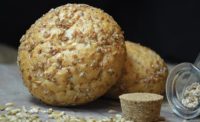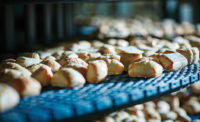The buns and rolls category has enjoyed a prosperous past 12 months, sparked in particular by the popularity of products like Hawaiian rolls. Significant room for growth remains for better-for-you products, including specialty-diet formulations focused on gluten-free and grain-free. Manufacturers will need to keep their eye on those potential areas of consumer interest while navigating the potentially more-difficult times ahead for all types of industries.
Overview | Bread | Tortillas | Sweet Goods | Snack Cakes | Pizza | Desserts | Cookies | Buns & Rolls | Bars | Breakfast Products
Market data
The buns and rolls category enjoyed a reasonably strong past year, according to data from IRI, Chicago, for the 52 weeks ending April 19. The hamburger and hot dog buns segment of fresh bread and rolls grew 5.6 percent to $2.3 billion in sales, while the “all other” fresh rolls/buns/croissants segment grew 8.5 percent to nearly $2.1 billion in sales.
Every company within the top 10 for hamburger and hot dog buns saw growth for the year. Private label maintained its significant lead, with $803.0 million in sales, up 0.7 percent. Grupo Bimbo was the highest-selling national brand, with $432.6 million in sales, up 9.3 percent. Lewis Bakeries saw the highest rate of growth, up 19.1 percent to $49.4 million.
In the “all other” subcategory, King’s Hawaiian Bakery West and its signature Hawaiian rolls leads the pack with sales of $587.8 million, up 16.4 percent for the year. Private label held strong with $550.5 million in sales, up 4.6 percent. Carrs Food—now known as St Pierre Group, the 2019 SF&WB “Bakery of the Year—had the highest rate of growth, up a fantastic 78.2 percent to $44.9 million. H&S Bakery also posted very strong numbers, up 22.6 percent to $20.2 million.
Looking back
Mel Festejo, COO, American Key Food Products, Closter, NJ, says the buns and rolls category is “quite mature.” He believes the challenge for brands has been to stand out in a crowded, high-quality marketplace. It’s why Hawaiian rolls have done well—they brought a sweeter, unique taste to the mix, he says.
The gluten-free market in the U.S. has done well, surging at least five to seven years ahead of even developed countries in Western Europe, he believes, in terms of formulations and quality—yet it’s tricky to match the qualities of buns and rolls that contain ingredients like eggs. “The way that gluten-free formulators deal with that is to try to compensate by throwing in a few more ingredients,” says Festejo. “You end up with a very long list.”
For most of the past year, consumers seemed interested in upscale, artisanal buns and rolls, with inclusions of new grains and seeds, as well as more sourdoughs in many markets, says Jeff Nelson, western vice president of sales, Brolite Products, Bartlett, IL. Brolite also has seen interest in low-carb and keto-friendly products in both white and multigrain formulations.
However, the balance of 2020 might look different. “In the current COVID-19 environment, the consumer has gone back to basics,” says Nelson.
La Brea Bakery, Los Angeles, has noticed increased interest in softer, sweeter rolls, says Brie Buenning, integrated marketing manager. “We are also seeing an increase in thaw-and-sell items that allow for less labor with the retailers and foodservice operators. Retailers and operators are faced with increased wages, slim margins, and unskilled labor, so offerings that can be slacked off or used immediately are a huge draw.”
Customers of Reiser, Canton, MA, are looking to improve their production lines to make them more flexible and versatile, says Ron Mullins, director of national bakery accounts. “This requires a divider that can process a wide range of absorption rates,” he says. “The lower absorption rates are often difficult for traditional extrusion dividers. Hard rolls with prints are typically run at a lower absorption.”
Reiser sees changing markets, with McDonald’s and other quick-service restaurants adding varieties like artisan, Kaiser or crusty sub rolls in different markets around the globe, Mullins says. Besides the divider, a dough chunker or a dough pump is added for versatility and to process doughs more gently, he says. “Longer reverse axis round tables add flexibility over short rounding tables used when processing only soft rolls.”
Prior to the coronavirus pandemic, companies making buns and rolls were increasingly concerned about sustainable packaging and the ability to reduce waste and cut down on plastics, instead using materials that are more environmentally friendly, says Dennis Gunnell, president, Formost Fuji, Woodinville, WA. “That was driving a lot of folks, even in the really traditional breads and buns industry, to look at how things are packaged,” he says. “You’re still going to have to have some type of plastic packaging—it’s too handy, too convenient. Plastic is used for a reason. It does a good job with those things, and it’s low-cost.” But if the cost of a more environmentally sustainable package only added 2 cents to a product, consumers might pay it, he adds.
However, during the pandemic, Gunnell suspects everyone in the supply chain will be rethinking all of that from a safety standpoint, with the disposability and protectiveness of plastic at least temporarily seeming like an advantage. “You’re going to see individual packaging,” he says. “I’ve had certain people call about individually wrapping products, one at a time, that weren’t individually wrapped before.”
Looking forward
Going forward, Festejo believes that formulations for healthier buns and rolls, whether gluten-free, grain-free, or vegan, will continue to improve. “It’s still a niche market, but it’s a market that’s not going away,” he says. “If there are going to be major strides experienced in the industry, it’s going to be in this area. It’s a quest for ingredients that perform better than they do today.”
American Key Food Products has been attuned to ingredients that have been out there for decades that could come into play in this regard, Festejo says. Among those are rice flour, which is gluten-free but typically adds an unpleasant grittiness for a bakery product because most rice flour in the U.S. is dry-milled. American Key Food Products has been working with a Japanese partner that uses wet milling to keep the texture lighter, he says.
In the conventional market, standing out among other bun and roll brands will continue to be challenging, Festejo believes. “It’s a crowded market that can give you good products wherever you are.” This means that companies need to come up with a signature product so that you will stand out above the rest, he says.
Brolite sees interest in low-carb and keto-friendly products continuing, although it’s hard to say what trends will develop, Nelson says. “The daily lives of our consumers have changed, and there is no telling how buying habits will adapt once the shelter-at-home ends,” he says. “While many consumers will go back to their pre-quarantine habits, some will get used to staying in more. They may find themselves continuing to buy from the in-store bakery and bread aisles.”
Sustainability, cleaner labels, and smaller pack sizes, including to-go items, had been trends prior to COVID-19, but consumer concerns about safety, along with the desire to stock up and cook more at home, have de-emphasized those trends, says Buenning. “As we transition to a new normal, we believe the trends such as cleaner label and sustainability will become a focus again. However, the approach will be different than before,” she says. “Brands are going to have to focus on sustainable packaging and operational techniques for environmental impacts, using upcycled ingredients, generating their own energy, and investing in packaging that is sealed, but recyclable.”
La Brea always has strived to be more sustainable in its operations and ingredients, and will continue to do so, Buenning says. “We will continue to focus on our Reserve line, which is heirloom grains, and continue to enhance our core,” she says. “We are also looking at revamping several of our lines to meet the changing needs of our customers and consumers.”
Mullins believes that customers will continue to want versatile bread and bun lines to produce a larger variety of products. “The complete line needs to be as versatile and as flexible as possible, while maintaining efficiency,” he says. “Suppliers should consider fast changeovers and ease of sanitation, especially when allergens are involved.”
Angela McDaniel, marketing and sales coordinator, Formost Fuji, suspects the rapidly cratering economy is causing makers of buns and rolls to revisit their plans for the second half of 2020, which began with many brands and manufacturers expanding and adding to their respective lineups. “It’s going to be a before-and-after effect,” she says. “We are seeing some of the plants not necessarily closing down, but rethinking.”
Gunnell sees specialty and higher-quality rolls like pretzel rolls being offered in alternative packaging. “People are going to see that the way we have always done it doesn’t necessarily have to be the only way,” he says. “If I were going to do it differently, what’s the package going to look like? How would I make it most user-friendly, efficient, and recyclable?”
To ensure that available equipment and technology helps create better bun and roll products that meet market opportunities, Gunnell suggests that companies bring together all relevant players, such as materials, equipment, and marketing personnel, to talk through strategies and tactics.
“If you try to do it in a vacuum, it’s going to run into roadblocks and take forever,” says Gunnell. “Get everybody together at the beginning and say, ‘Where do we want to go with this? What options do we have?’ Put it all on the table.”
Overview | Bread | Tortillas | Sweet Goods | Snack Cakes | Pizza | Desserts | Cookies | Buns & Rolls | Bars | Breakfast Products







